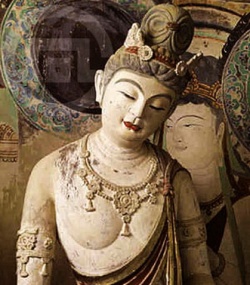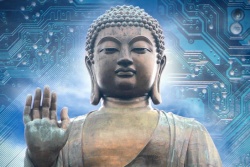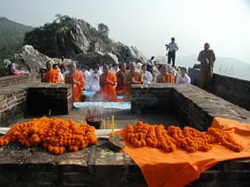How Sanghāta Sūtra Came to the West (and many other places)
The Sanghāta Sūtra comes into your hands through a long chain of interdependent arisings—a chain that was very nearly broken. For many centuries the Sanghāta Sūtra was actively recited, copied, translated and treasured, in both India and across central Asia, as we know from the large numbers of manuscripts that have survived of the Sanghāta Sūtra. But all this activity seems to have stopped some time after the eighth century CE, when the Sanghāta fell into obscurity.
It is unclear why, or exactly when, the Sanghāta slipped out of view. The original Sanskrit was lost altogether. Translations were preserved in the Tibetan and Chinese canons, and fragments of translations into a number of lost central Asian languages also survived. But the Sanghāta sat silently in these canonical collections, preserved and transmitted in physical form, but unread, un-recited, and un-celebrated.
The first step in the chain of events that brought the Sanghāta back to active circulation took place in the 1930s, in the very northernmost reaches of Pakistan. There, villagers living in a dry and mountainous place called Gilgit stumbled across a buried stupa housing a collection of Sanskrit manuscripts written on fragile and crumbling birch-bark scrolls. At first, the villagers agreed to leave the stupa undisturbed, recognizing its sacred nature.
But apparently not all villagers were in full agreement. When some very ancient manuscripts began to appear for sale in nearby markets, the British colonial administrators of the area took notice, investigated the source, and ordered an archeological excavation of the stupa site. The excavation revealed a cache of Sanskrit Buddhist scriptures that rocked the world of Buddhist scholars. Included in this priceless collection were original Sanskrit versions of many of the best known scriptures of Mahāyāna Buddhism – the Diamond Cutter Sutra, the Eight-Thousand Verse Perfection of Wisdom Sutra, and the Lotus Sutra. But of all the texts preserved in this stūpa, more copies of the Sanghāta Sūtra were found than any other text. These manuscripts date from over the course of several centuries, indicating that the Sanghāta had held a crucial place in the hearts and practice of Buddhists over the course of many centuries.
What happened to veil the Sanghāta Sūtra and remove it from the lives of Buddhist practitioners, we do not know. But we do know how it came back to light. After the manuscripts were unearthed, Western scholars began studying the previously lost Sanskrit version. An edition of the Sanskrit text comparing it to a translation into the Khotanese language was published by Giotto Canevascini, a European scholar specializing in linguistic analysis of Buddhist texts. Then, in the 1990s, while two American scholars—Karen Derris and Ed Murphy—were graduate students at Harvard, Ed presented a copy of the text to their professor, Charles Hallisey. [This same Ed Murphy now provides the technical services and server hosting this website.] Professor Hallisey in turn assigned it to a class attended by an American Buddhist nun named Damchö [who provides the editorial content of this website.]
That nun was fortunate enough to be able to offer a copy of the text to Lama Zopa Rinpoche, and the rest of the story is Sanghāta Sūtra history: The very first day Rinpoche read the text in Madison, Wisconsin, in summer of 2002, Rinpoche made a commitment to write the entire Sanghāta Sūtra by hand in gold on rainbow-colored paper to place in the 500-foot Maitreya statue being built in India, and to have it translated into many languages. Since that day just three years ago, the Sanghāta Sūtra has indeed been translated into English, French, Spanish, Italian, Vietnamese, and Japanese. And the banner of this website pictures Rinpoche in the process of writing the first page of the sutra in gold ink.
Lama Zopa Rinpoche has also sought out the oral transmission of the text, and begun passing that transmission on to students worldwide. Rinpoche has commissioned translations of the text, sponsored hundreds of copies of the text, assigned recitation of the Sanghāta Sūtra as a weekly practice, and requested thousands of recitations of the text for various purposes – including on the anniversary of September 11, and for victims of the tsunami in 2004. It is precisely Rinpoche’s loving concern for his students and for sentient beings that has propelled the Sanghāta Sūtra back into an important position in the lives of many Buddhist practitioners.
The story of the Sanghāta begins with the fullness of the Buddha’s compassion for all of us sentient beings, for whom the teaching was first left in the world. Later, through the painstaking effort and loving care of generations of practitioners, reciters, copyists, and translators, the presence of the Sanghāta in the world was preserved for us, over all these centuries that separate us from the first moment of its utterance. For a time it lay dormant in the canons in only its physical form, until the interest of academic scholars drew attention to the sutra's content. Most recently, it has been the transformational involvement of Lama Zopa Rinpoche that has brought this wondrous text back into the light of day, and into the light of so many practitioners’ hearts.


